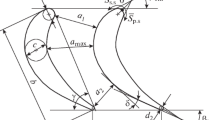Abstract—
The results from experimental studies of flat turbine airfoil cascades carried out at a steam setup are presented. Cascades having the same airfoil featuring an increased velocity vector circulation rate around the airfoil and also ones with modified initial airfoil versions were considered. The steam flow inlet and outlet angles for the airfoil cascades are approximately 50°/14°; the blade length is 100 mm, and the airfoil chord is 40.64 mm. The cascade blowing experiments were carried out at Re > 4 × 105. The cascades of S-13GM airfoils were studied in a wide airfoil relative pitch variation range of 0.55‒0.98 and Mach number variation range M ≈ 0.5‒1.1. The initial blade airfoil had a configuration close to the well-known S-5515A airfoil developed at the Moscow Power Engineering Institute (MPEI). The optimal values of the airfoil relative pitch in the cascade versus the Mach number have been determined. It has been found that there are two energy loss minimums depending on the relative pitch of such airfoils in the cascade. Some technical solutions are suggested for reducing the total energy losses in the cascade of airfoils through adjusting the steam flow by design measures. The effect of incidence angles on the energy losses in the cascade of airfoils with and without a vortex chamber on the airfoil is studied. The effect the change in some geometrical and flowrate parameters in airfoil cascades has on the steam energy losses during the flow in the interblade channel is shown. A profiled slot at blade tips and also a two-row cascade increase the energy losses. A vortex chamber made on the airfoil convex part decreases the total energy losses in the cascade by approximately 0.5‒1.0% with М = 0.8‒0.9 and by 3% with М = 1.0; the decrease of total energy losses in the cascade with short blades may reach approximately 4%. Based on the geometrical similarity to the dolphin body outlines and profile smoothing methods, turbine blade airfoils have been fabricated and tested, which have shown high gas dynamic properties. The cascades assembled of airfoils of such type such show efficient performance, especially in operating on wet steam.














Similar content being viewed by others
REFERENCES
M. E. Deich, Gas Dynamics of Turbomachine Cascades (Energoatomizdat, Moscow, 1996) [in Russian].
N. G. Rodionov, A. A. Dakhnovich, and A. S. Goldin, “Study of turbine profile cascades with vortex cavities on profiles,” Teploenergetika, No. 1, 72–74 (1995).
N. G. Rodionov and A. S. Goldin, “Results of studies of turbine cascades with vortex cavities on backs of profiles,” in Proc. 4th All-Russian Interbranch Sci.-Tech. Conf. on Topical Issues of Marine Power Engineering (S.-Peterb. Gos. Morsk. Tekh. Univ., St. Petersburg, 2015), pp. 116–118.
N. G. Rodionov, “Equipment for experimental studies of flow paths of steam turbines using water vapor,” in Proc. 9th Int. Sci.-Tech. Conf. (S.-Peterb. Gos. Morsk. Tekh. Univ., St. Petersburg, 2020), pp. 230–234.
M. Ye. Deych, G. A. Philipp, and L. Ya. Lazarev, Atlas of the Cascade Profiles of Axial-Flows Turbine (Mashinostroenie, Moscow, 1965; Ft. Belvoir Defense Technical Information Center, Springfield, Va., 1976).
M. Kh. Mukhtarov and V. I. Krichakin, “Methodology for assessing losses in the flow path of axial turbines when calculating their characteristics,” Teploenergetika, No. 7, 76–79 (1965).
A. M. Topunov and B. A. Tikhomirov, Flow Control in Thermal Turbines (Mashinostroenie, Leningrad, 1979) [in Russian].
V. N. Osinkin and Yu. I. Mityushkin, “Study of the flow behind a flat two-row profile cascade,” Tr. LKI, No. 101, 71–77 (1975).
V. N. Osinkin, Study of Subsonic Turbine Stages with Double-Row Nozzle Cascades, Candidate’s Dissertation in Engineering (Leningrad Ship Construction Inst., Leningrad, 1978).
P. K. Chang, Control of Flow Separation: Energy Conservation, Operational Efficiency, and Safety (Hemisphere, Washington, DC, 1976; Mir, Moscow, 1979).
P. K. Chang, Separation of Flow (Pergamon, Oxford, 1970; Mir, Moscow, 1972).
Reference Materials. Optical-Physical Methods and Research Tools in Experimental Gas Dynamics (GONTI-1, Moscow, 1989) [in Russian].
L. M. Soroko, Holography and Coherent Optics (Nauka, Moscow, 1975; Plenum, New York, 1980).
J. H. Horlock, Axial Flow Turbines: Fluid Mechanics and Thermodynamics (Butterworths, London, 1966; Mashinostroenie, Moscow, 1972).
V. P. Sochivko, Essays on the Bionics of the Sea (Sudostroenie, Leningrad, 1968) [in Russian].
Author information
Authors and Affiliations
Corresponding author
Additional information
Translated by V. Filatov
Rights and permissions
About this article
Cite this article
Rodionov, N.G. Experimental Studies of Airfoil Cascades with High Velocity Vector Circulation around the Airfoil. Therm. Eng. 69, 42–50 (2022). https://doi.org/10.1134/S0040601521110033
Received:
Revised:
Accepted:
Published:
Issue Date:
DOI: https://doi.org/10.1134/S0040601521110033



